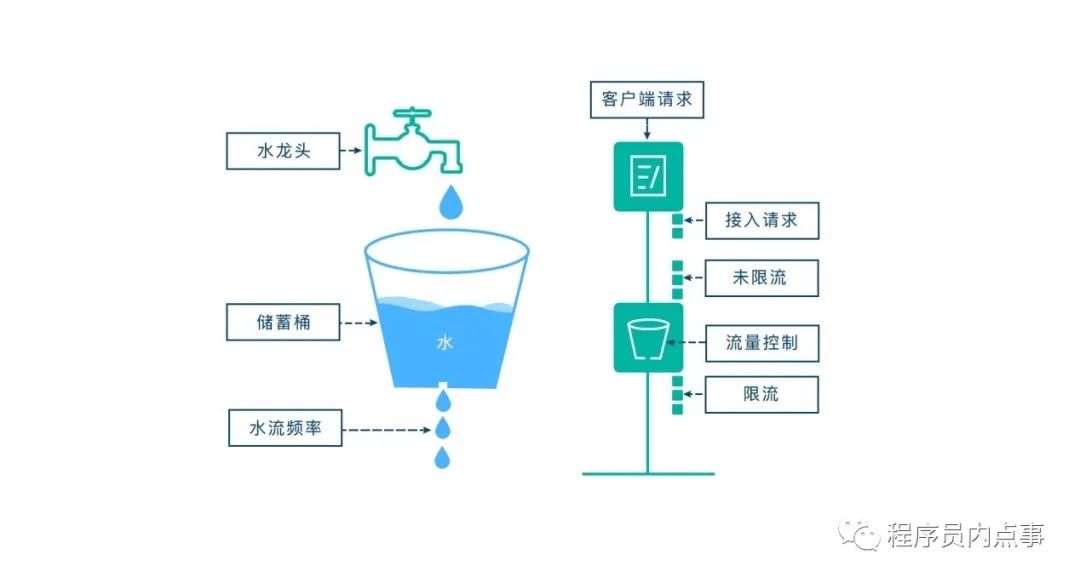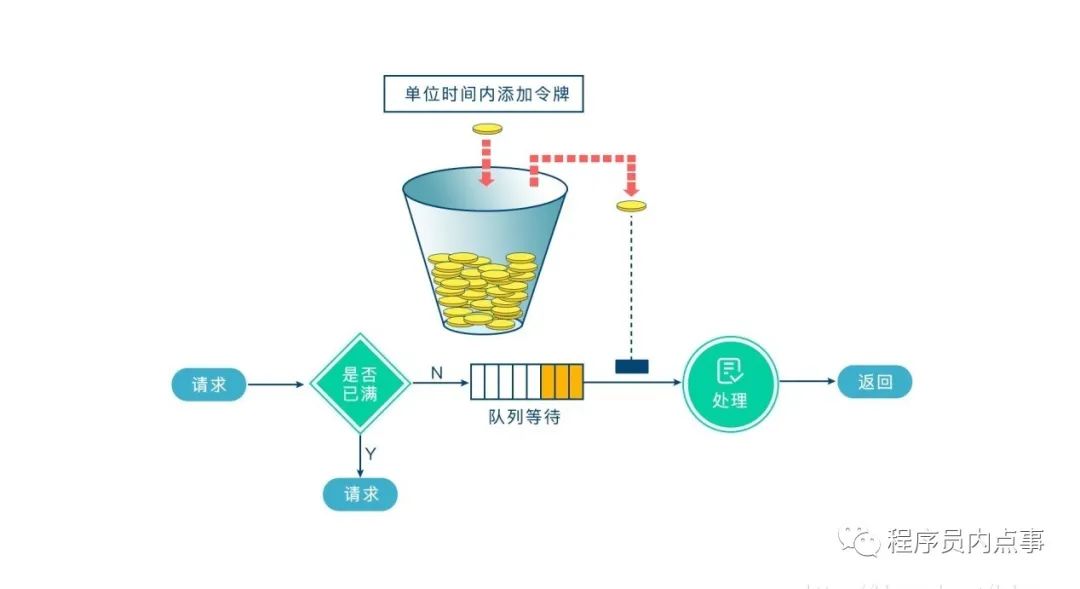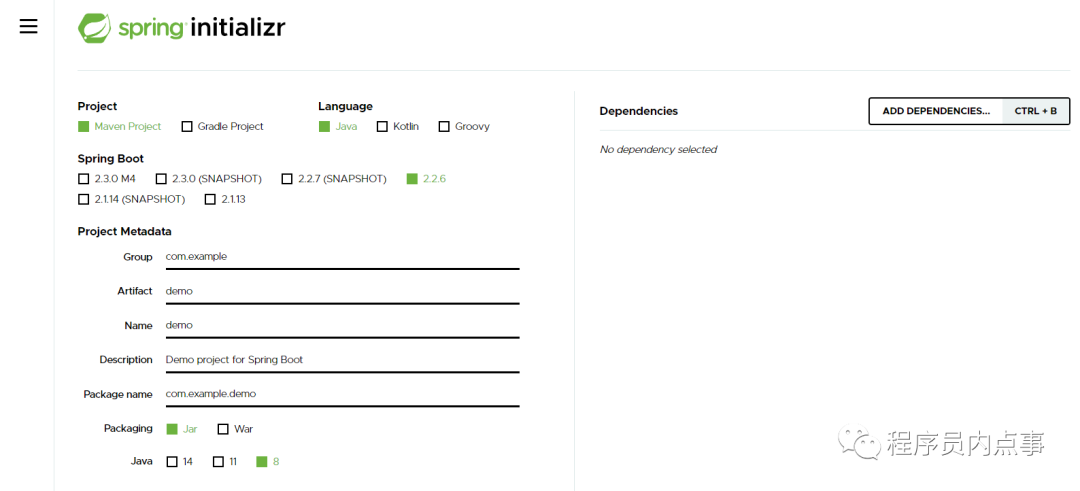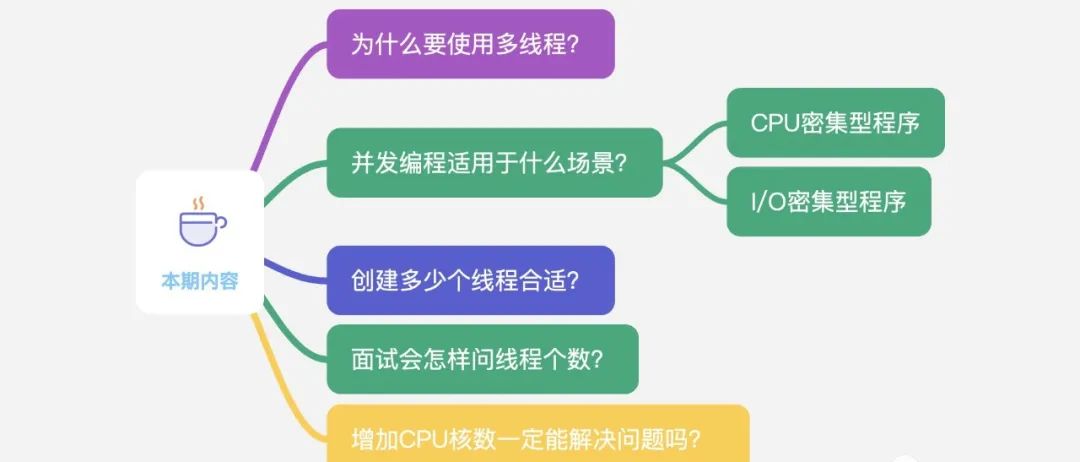点击蓝色「日拱一兵」关注,持续侦破 Java 技术案件
一、什么是限流?为什么要限流?
不知道大家有没有做过帝都的地铁,就是进地铁站都要排队的那种,为什么要这样摆长龙转圈圈?答案就是为了限流!因为一趟地铁的运力是有限的,一下挤进去太多人会造成站台的拥挤、列车的超载,存在一定的安全隐患。同理,我们的程序也是一样,它处理请求的能力也是有限的,一旦请求多到超出它的处理极限就会崩溃。为了不出现最坏的崩溃情况,只能耽误一下大家进站的时间。

限流是保证系统高可用的重要手段!!!
由于互联网公司的流量巨大,系统上线会做一个流量峰值的评估,尤其是像各种秒杀促销活动,为了保证系统不被巨大的流量压垮,会在系统流量到达一定阈值时,拒绝掉一部分流量。
限流会导致用户在短时间内(这个时间段是毫秒级的)系统不可用,一般我们衡量系统处理能力的指标是每秒的QPS或者TPS,假设系统每秒的流量阈值是1000,理论上一秒内有第1001个请求进来时,那么这个请求就会被限流。
二、限流方案
1、计数器
Java内部也可以通过原子类计数器AtomicInteger、Semaphore信号量来做简单的限流。
1// 限流的个数
2 private int maxCount = 10;
3 // 指定的时间内
4 private long interval = 60;
5 // 原子类计数器
6 private AtomicInteger atomicInteger = new AtomicInteger(0);
7 // 起始时间
8 private long startTime = System.currentTimeMillis();
9
10 public boolean limit(int maxCount, int interval) {
11 atomicInteger.addAndGet(1);
12 if (atomicInteger.get() == 1) {
13 startTime = System.currentTimeMillis();
14 atomicInteger.addAndGet(1);
15 return true;
16 }
17 // 超过了间隔时间,直接重新开始计数
18 if (System.currentTimeMillis() - startTime > interval * 1000) {
19 startTime = System.currentTimeMillis();
20 atomicInteger.set(1);
21 return true;
22 }
23 // 还在间隔时间内,check有没有超过限流的个数
24 if (atomicInteger.get() > maxCount) {
25 return false;
26 }
27 return true;
28 }
2、漏桶算法
漏桶算法思路很简单,我们把水比作是请求,漏桶比作是系统处理能力极限,水先进入到漏桶里,漏桶里的水按一定速率流出,当流出的速率小于流入的速率时,由于漏桶容量有限,后续进入的水直接溢出(拒绝请求),以此实现限流。

3、令牌桶算法
令牌桶算法的原理也比较简单,我们可以理解成医院的挂号看病,只有拿到号以后才可以进行诊病。
系统会维护一个令牌(token)桶,以一个恒定的速度往桶里放入令牌(token),这时如果有请求进来想要被处理,则需要先从桶里获取一个令牌(token),当桶里没有令牌(token)可取时,则该请求将被拒绝服务。令牌桶算法通过控制桶的容量、发放令牌的速率,来达到对请求的限制。

4、Redis + Lua
很多同学不知道Lua是啥?个人理解,Lua脚本和 MySQL数据库的存储过程比较相似,他们执行一组命令,所有命令的执行要么全部成功或者失败,以此达到原子性。也可以把Lua脚本理解为,一段具有业务逻辑的代码块。
而Lua本身就是一种编程语言,虽然redis 官方没有直接提供限流相应的API,但却支持了 Lua 脚本的功能,可以使用它实现复杂的令牌桶或漏桶算法,也是分布式系统中实现限流的主要方式之一。
相比Redis事务,Lua脚本的优点:
减少网络开销:使用
Lua脚本,无需向Redis发送多次请求,执行一次即可,减少网络传输原子操作:
Redis将整个Lua脚本作为一个命令执行,原子,无需担心并发复用:
Lua脚本一旦执行,会永久保存Redis中,,其他客户端可复用
Lua脚本大致逻辑如下:
1-- 获取调用脚本时传入的第一个key值(用作限流的 key)
2local key = KEYS[1]
3-- 获取调用脚本时传入的第一个参数值(限流大小)
4local limit = tonumber(ARGV[1])
5
6-- 获取当前流量大小
7local curentLimit = tonumber(redis.call('get', key) or "0")
8
9-- 是否超出限流
10if curentLimit + 1 > limit then
11 -- 返回(拒绝)
12 return 0
13else
14 -- 没有超出 value + 1
15 redis.call("INCRBY", key, 1)
16 -- 设置过期时间
17 redis.call("EXPIRE", key, 2)
18 -- 返回(放行)
19 return 1
20end
通过
KEYS[1]获取传入的key参数通过
ARGV[1]获取传入的limit参数redis.call方法,从缓存中get和key相关的值,如果为null那么就返回0接着判断缓存中记录的数值是否会大于限制大小,如果超出表示该被限流,返回0
如果未超过,那么该key的缓存值+1,并设置过期时间为1秒钟以后,并返回缓存值+1
这种方式是本文推荐的方案,具体实现会在后边做细说。
5、网关层限流
限流常在网关这一层做,比如Nginx、Openresty、kong、zuul、Spring Cloud Gateway等,而像spring cloud - gateway网关限流底层实现原理,就是基于Redis + Lua,通过内置Lua限流脚本的方式。

三、Redis + Lua 限流实现
下面我们通过自定义注解、aop、Redis + Lua 实现限流,步骤会比较详细,为了小白能让快速上手这里啰嗦一点,有经验的老鸟们多担待一下。
1、环境准备
springboot 项目创建地址:https://start.spring.io,很方便实用的一个工具。

2、引入依赖包
pom文件中添加如下依赖包,比较关键的就是 spring-boot-starter-data-redis 和 spring-boot-starter-aop。
1 2 <dependency> 3 <groupId>org.springframework.bootgroupId> 4 <artifactId>spring-boot-starter-webartifactId> 5 dependency> 6 7 <groupId>org.springframework.bootgroupId> 8 spring-boot-starter-data-redis</artifactId> 9 dependency>10 <dependency>11 <groupId>org.springframework.bootgroupId>12 <artifactId>spring-boot-starter-aopartifactId>13 dependency>14 15 <groupId>com.google.guavagroupId>16 guava</artifactId>17 21.0version>18 dependency>19 20 <groupId>org.springframework.bootgroupId>21 spring-boot-starter-test</artifactId>22 dependency>23 <dependency>24 <groupId>org.apache.commonsgroupId>25 <artifactId>commons-lang3artifactId>26 dependency>2728 29 <groupId>org.springframework.bootgroupId>30 spring-boot-starter-test</artifactId>31 testscope>32 <exclusions>33 <exclusion>34 <groupId>org.junit.vintagegroupId>35 <artifactId>junit-vintage-engineartifactId>36 exclusion>37 exclusions>38 </dependency>39 dependencies>3、配置application.properties
在 application.properties 文件中配置提前搭建好的 redis 服务地址和端口。
1spring.redis.host=127.0.0.1
2
3spring.redis.port=6379
4、配置RedisTemplate实例
1@Configuration
2public class RedisLimiterHelper {
3
4 @Bean
5 public RedisTemplate<String, Serializable> limitRedisTemplate(LettuceConnectionFactory redisConnectionFactory) {
6 RedisTemplate<String, Serializable> template = new RedisTemplate<>();
7 template.setKeySerializer(new StringRedisSerializer());
8 template.setValueSerializer(new GenericJackson2JsonRedisSerializer());
9 template.setConnectionFactory(redisConnectionFactory);
10 return template;
11 }
12}
限流类型枚举类
1/** 2 * @author fu 3 * @description 限流类型 4 * @date 2020/4/8 13:47 5 */
6public enum LimitType {
7
8 /** 9 * 自定义key10 */
11 CUSTOMER,
12
13 /**14 * 请求者IP15 */
16 IP;
17}
5、自定义注解
我们自定义个@Limit注解,注解类型为ElementType.METHOD即作用于方法上。
period表示请求限制时间段,count表示在period这个时间段内允许放行请求的次数。limitType代表限流的类型,可以根据请求的IP、自定义key,如果不传limitType属性则默认用方法名作为默认key。
1/** 2 * @author fu 3 * @description 自定义限流注解 4 * @date 2020/4/8 13:15 5 */
6@Target({ElementType.METHOD, ElementType.TYPE})
7@Retention(RetentionPolicy.RUNTIME)
8@Inherited
9@Documented
10public @interface Limit {
11
12 /**13 * 名字14 */
15 String name() default "";
16
17 /**18 * key19 */
20 String key() default "";
21
22 /**23 * Key的前缀24 */
25 String prefix() default "";
26
27 /**28 * 给定的时间范围 单位(秒)29 */
30 int period();
31
32 /**33 * 一定时间内最多访问次数34 */
35 int count();
36
37 /**38 * 限流的类型(用户自定义key 或者 请求ip)39 */
40 LimitType limitType() default LimitType.CUSTOMER;
41}
6、切面代码实现
1/** 2 * @author fu 3 * @description 限流切面实现 4 * @date 2020/4/8 13:04 5 */
6@Aspect
7@Configuration
8public class LimitInterceptor {
9
10 private static final Logger logger = LoggerFactory.getLogger(LimitInterceptor.class);
11
12 private static final String UNKNOWN = "unknown";
13
14 private final RedisTemplate<String, Serializable> limitRedisTemplate;
15
16 @Autowired
17 public LimitInterceptor(RedisTemplate<String, Serializable> limitRedisTemplate) {
18 this.limitRedisTemplate = limitRedisTemplate;
19 }
20
21 /** 22 * @param pjp 23 * @author fu 24 * @description 切面 25 * @date 2020/4/8 13:04 26 */
27 @Around("execution(public * *(..)) && @annotation(com.xiaofu.limit.api.Limit)")
28 public Object interceptor(ProceedingJoinPoint pjp) {
29 MethodSignature signature = (MethodSignature) pjp.getSignature();
30 Method method = signature.getMethod();
31 Limit limitAnnotation = method.getAnnotation(Limit.class);
32 LimitType limitType = limitAnnotation.limitType();
33 String name = limitAnnotation.name();
34 String key;
35 int limitPeriod = limitAnnotation.period();
36 int limitCount = limitAnnotation.count();
37
38 /** 39 * 根据限流类型获取不同的key ,如果不传我们会以方法名作为key 40 */
41 switch (limitType) {
42 case IP:
43 key = getIpAddress();
44 break;
45 case CUSTOMER:
46 key = limitAnnotation.key();
47 break;
48 default:
49 key = StringUtils.upperCase(method.getName());
50 }
51
52 ImmutableList<String> keys = ImmutableList.of(StringUtils.join(limitAnnotation.prefix(), key));
53 try {
54 String luaScript = buildLuaScript();
55 RedisScript<Number> redisScript = new DefaultRedisScript<>(luaScript, Number.class);
56 Number count = limitRedisTemplate.execute(redisScript, keys, limitCount, limitPeriod);
57 logger.info("Access try count is {} for name={} and key = {}", count, name, key);
58 if (count != null && count.intValue() <= limitCount) {
59 return pjp.proceed();
60 } else {
61 throw new RuntimeException("You have been dragged into the blacklist");
62 }
63 } catch (Throwable e) {
64 if (e instanceof RuntimeException) {
65 throw new RuntimeException(e.getLocalizedMessage());
66 }
67 throw new RuntimeException("server exception");
68 }
69 }
70
71 /** 72 * @author fu 73 * @description 编写 redis Lua 限流脚本 74 * @date 2020/4/8 13:24 75 */
76 public String buildLuaScript() {
77 StringBuilder lua = new StringBuilder();
78 lua.append("local c");
79 lua.append("\nc = redis.call('get',KEYS[1])");
80 // 调用不超过最大值,则直接返回
81 lua.append("\nif c and tonumber(c) > tonumber(ARGV[1]) then");
82 lua.append("\nreturn c;");
83 lua.append("\nend");
84 // 执行计算器自加
85 lua.append("\nc = redis.call('incr',KEYS[1])");
86 lua.append("\nif tonumber(c) == 1 then");
87 // 从第一次调用开始限流,设置对应键值的过期
88 lua.append("\nredis.call('expire',KEYS[1],ARGV[2])");
89 lua.append("\nend");
90 lua.append("\nreturn c;");
91 return lua.toString();
92 }
93
94
95 /** 96 * @author fu 97 * @description 获取id地址 98 * @date 2020/4/8 13:24 99 */
100 public String getIpAddress() {
101 HttpServletRequest request = ((ServletRequestAttributes) RequestContextHolder.getRequestAttributes()).getRequest();
102 String ip = request.getHeader("x-forwarded-for");
103 if (ip == null || ip.length() == 0 || UNKNOWN.equalsIgnoreCase(ip)) {
104 ip = request.getHeader("Proxy-Client-IP");
105 }
106 if (ip == null || ip.length() == 0 || UNKNOWN.equalsIgnoreCase(ip)) {
107 ip = request.getHeader("WL-Proxy-Client-IP");
108 }
109 if (ip == null || ip.length() == 0 || UNKNOWN.equalsIgnoreCase(ip)) {
110 ip = request.getRemoteAddr();
111 }
112 return ip;
113 }
114}
7、控制层实现
我们将@Limit注解作用在需要进行限流的接口方法上,下边我们给方法设置@Limit注解,在10秒内只允许放行3个请求,这里为直观一点用AtomicInteger计数。
1/** 2 * @Author: fu 3 * @Description: 4 */
5@RestController
6public class LimiterController {
7
8 private static final AtomicInteger ATOMIC_INTEGER_1 = new AtomicInteger();
9 private static final AtomicInteger ATOMIC_INTEGER_2 = new AtomicInteger();
10 private static final AtomicInteger ATOMIC_INTEGER_3 = new AtomicInteger();
11
12 /**13 * @author fu14 * @description15 * @date 2020/4/8 13:4216 */
17 @Limit(key = "limitTest", period = 10, count = 3)
18 @GetMapping("/limitTest1")
19 public int testLimiter1() {
20
21 return ATOMIC_INTEGER_1.incrementAndGet();
22 }
23
24 /**25 * @author fu26 * @description27 * @date 2020/4/8 13:4228 */
29 @Limit(key = "customer_limit_test", period = 10, count = 3, limitType = LimitType.CUSTOMER)
30 @GetMapping("/limitTest2")
31 public int testLimiter2() {
32
33 return ATOMIC_INTEGER_2.incrementAndGet();
34 }
35
36 /**37 * @author fu38 * @description 39 * @date 2020/4/8 13:4240 */
41 @Limit(key = "ip_limit_test", period = 10, count = 3, limitType = LimitType.IP)
42 @GetMapping("/limitTest3")
43 public int testLimiter3() {
44
45 return ATOMIC_INTEGER_3.incrementAndGet();
46 }
47
48}
8、测试
测试预期:连续请求3次均可以成功,第4次请求被拒绝。接下来看一下是不是我们预期的效果,请求地址:http://127.0.0.1:8080/limitTest1,用postman进行测试,有没有postman url直接贴浏览器也是一样。

可以看到第四次请求时,应用直接拒绝了请求,说明我们的 Springboot + aop + lua 限流方案搭建成功。

总结
以上 springboot + aop + Lua 限流实现是比较简单的,旨在让大家认识下什么是限流?如何做一个简单的限流功能,面试要知道这是个什么东西。上面虽然说了几种实现限流的方案,但选哪种还要结合具体的业务场景,不能为了用而用

面试问我,创建多少个线程合适?我该怎么说

读JDK源码,可以边读边加注释的姿势怎么样?

Java SPI 机制,你的数据库驱动就是靠它加载的











)








